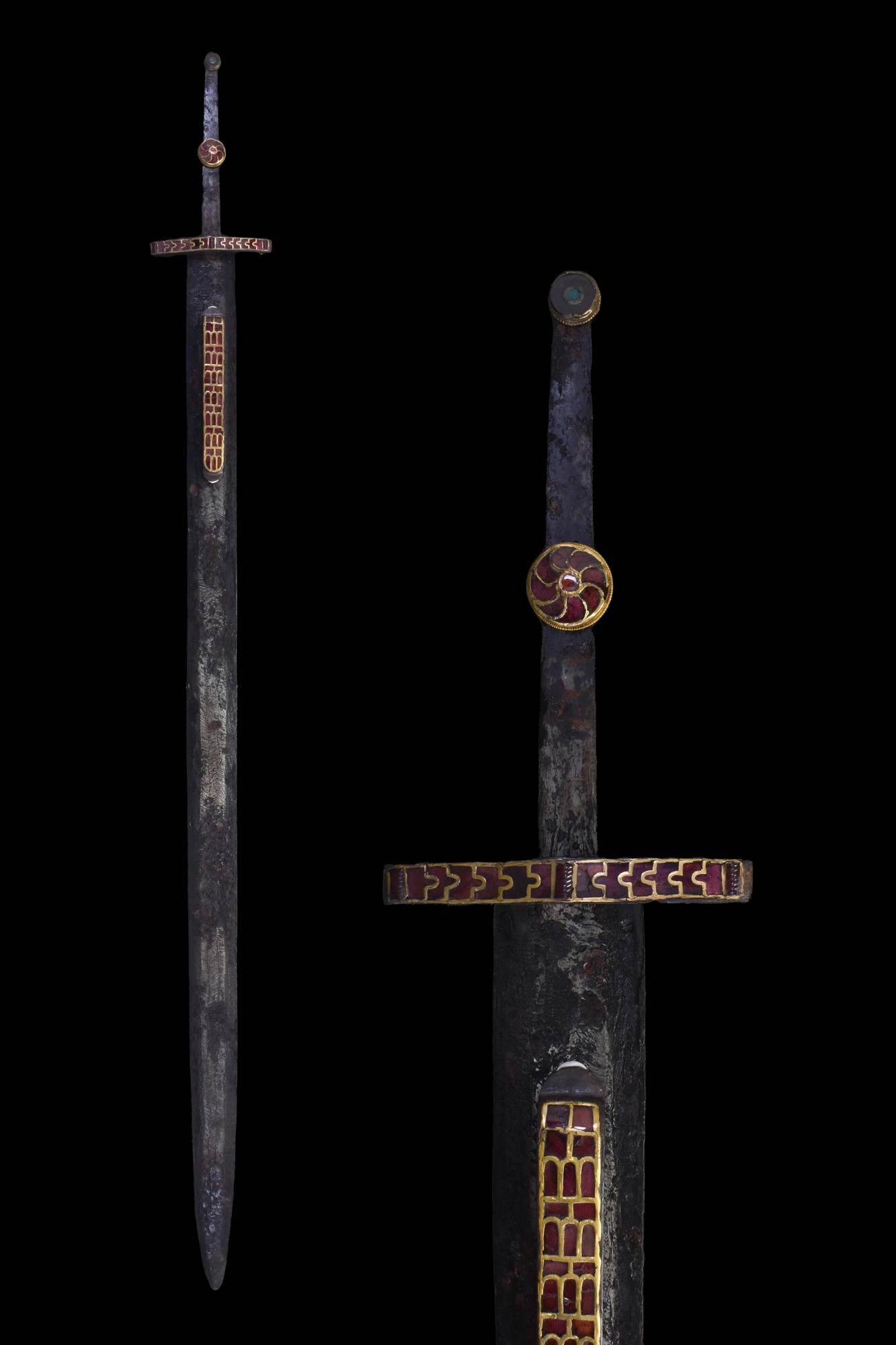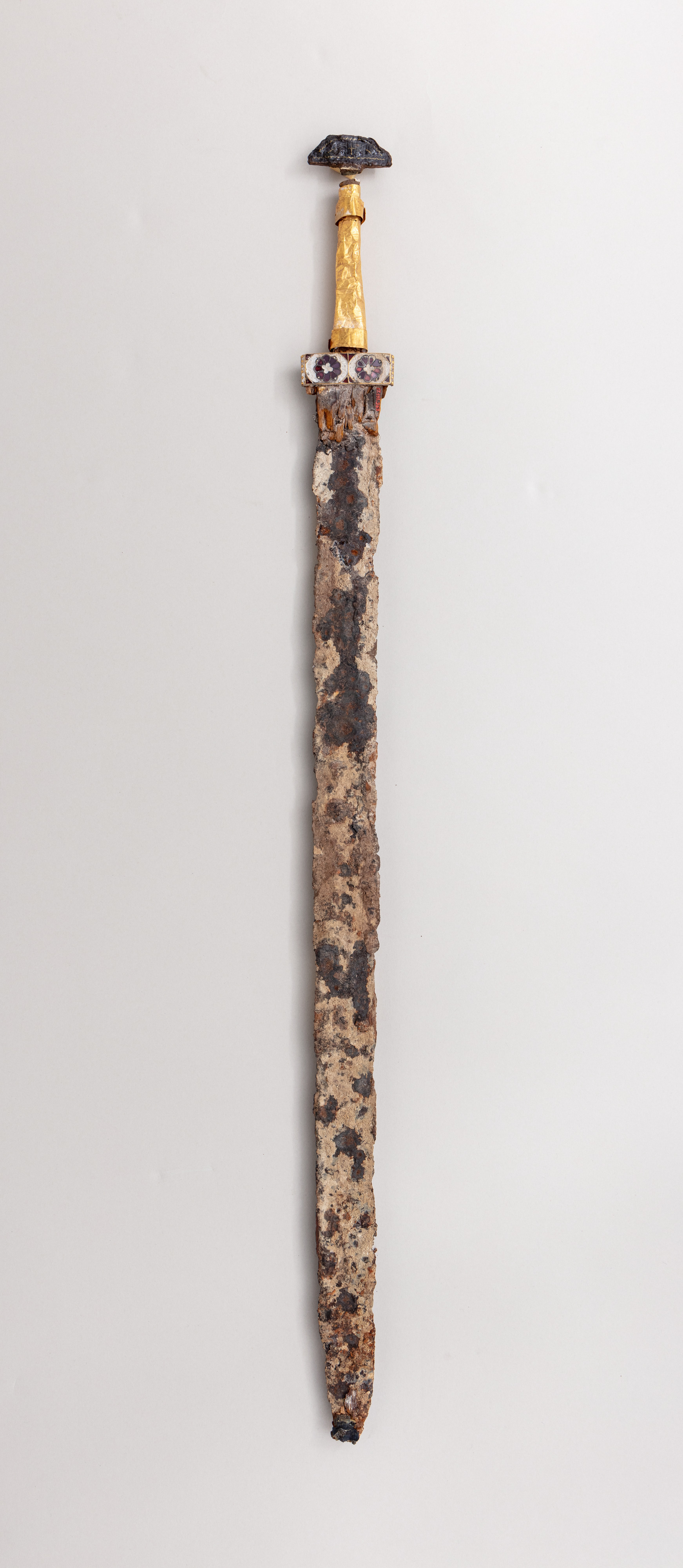| Author |
Message |
Pedro Paulo Gaião

|
 Posted: Fri 21 Apr, 2023 2:47 am Post subject: Early Medieval Two Handed Swords? Auction pieces. Posted: Fri 21 Apr, 2023 2:47 am Post subject: Early Medieval Two Handed Swords? Auction pieces. |
 |
|
I have been discussing some swords sold in auctions, but I think it would be better to show them here, the first two I believe to be forgeries, while the third one might have historical.

It's claimed, without much info or sources, it's a Merovingian sword dated 600 AD, apparently sold in an auction at Russia. The garnet and gold decoration appears in some Migration Era Swords, notably in the Sutton Hoo sword, but the size of the whole guard doesn't match anything I know, while the pommel seems more of a 13-14th century thing. I suspect they just assembled a 14th-century blade with the pommel and forged the guard.

A "Merovingian" pattern welded blade dated 600 AD, sold in jan 2023. The auction description reads: "Size: L:1050mm / W:105mm ; 785g Provenance: Formerly in a collection of a European collector; previously in a Belgian collection of Mr. R. Bogaert, 1970s-1990s."
https://www.the-saleroom.com/en-gb/auction-catalogues/apollo-art/catalogue-id-pax-ro10040/lot-8f14b026-ba10-41d0-a4d0-af720089db90
While the hilt isn't as tall as the other, it's really too large and the blade decoration stands out from the Migration Era.
So, Byzantine swords are understudied compared to Western ones (and we have interesting hilt shapes like this, but as far as I'm aware there aren't much artistic evidence for bastard/two handed swords in Byzantine artistic evidence, besides some clear Western type blades.

https://sword-site.com/thread/922/hander-byzantine-sword?fbclid=IwAR3fl740v1eCJhE57FbcoUmuVdvtuoUSHsWIZf4rKOegzPoMmqKkertTXEk
It's also claimed to be Fatimid and Seljuk, sold at 2010. Jack Loomes said the blade is 65cm, which is shorter than Migration Era Swords, and likely a continuation of the shorter Roman Spathae in the Byzantine world. A reproduction of this piece has a total length of 82cm , but I don't think it's a good hilt repro, anyways.
I'm unsure if a Western-oriented datation is adequate for weapons like this. They gave 10th-11th century, probably because the guard is too long to predate the 950-1050 phenomenon of longer guards, while the blade is a sort of type X.
Extra (edit): apparently they found some byzantine swords in Amorium with the same hilt style of the first forgery:

https://greekcitytimes.com/2022/02/15/amorium-byzantine-greek-turkish/
The place also has a couple of interesting pieces as well: https://www.livescience.com/rare-byzantine-swords-discovered
I would really like to see a discussion about them.
“Burn old wood, read old books, drink old wines, have old friends.”
Alfonso X, King of Castile (1221-84)
|
|
  |
 |
|
Sean Manning
|
 Posted: Fri 21 Apr, 2023 4:00 pm Post subject: Posted: Fri 21 Apr, 2023 4:00 pm Post subject: |
 |
|
Pedro, I don't think Byzantine or early Islamic swords are understudied, there is just far less evidence for them than for swords of the Han Dynasty or swords of the Viking Age. Without hundreds or thousands of swords from known archaeological contexts, its hard to interpret things of unknown origin on random auctions (and hard to write the coffeetable books and children's books that get the public interested).
Objects from the former Soviet Union, like the sword in the Facebook post, are usually only published in Slavic languages. Some of those books and articles look really good but I can't read them!
I agree that we should be skeptical of swords appearing in auctions which can't be traced to a recorded find or an old collection.
weekly writing ~ material culture
|
|
  |
 |
Pedro Paulo Gaião

|
 Posted: Sun 30 Apr, 2023 9:59 am Post subject: Posted: Sun 30 Apr, 2023 9:59 am Post subject: |
 |
|
| Sean Manning wrote: | Pedro, I don't think Byzantine or early Islamic swords are understudied, there is just far less evidence for them than for swords of the Han Dynasty or swords of the Viking Age. Without hundreds or thousands of swords from known archaeological contexts, its hard to interpret things of unknown origin on random auctions (and hard to write the coffeetable books and children's books that get the public interested).
Objects from the former Soviet Union, like the sword in the Facebook post, are usually only published in Slavic languages. Some of those books and articles look really good but I can't read them!
I agree that we should be skeptical of swords appearing in auctions which can't be traced to a recorded find or an old collection. |
Which authors do you have in mind for Byzantine and Islamic swords?
By the way, I was discussing with a curator another garnet hilt "Merovingian sword", from a former Zurich's collection:


According to the seller: "43¼in. (110cm.) length of sword and grip"
https://www.bonhams.com/auctions/11597/lot/302/
The golden wrap actually is a thing from the period, judging by this authentic 6th century Merovingian sword at the MET:

Dimensions: L. 32 1/4 in. (81.9 cm); L. of blade 26 1/4 in. (66.7 cm); W. 2 5/16 in. (5.9 cm); Wt. 1 lb. 2 oz. (510 g)
The curator thinks it's most likely a cavalry sword whose golden wrap is not in place, and with a handle not fit for bastard/two handed use, but I'm unsure.
Are they really insisting on this?
“Burn old wood, read old books, drink old wines, have old friends.”
Alfonso X, King of Castile (1221-84)
|
|
  |
 |
|
Sean Manning
|
 Posted: Sun 30 Apr, 2023 12:20 pm Post subject: Posted: Sun 30 Apr, 2023 12:20 pm Post subject: |
 |
|
I don't know, neither is my specialty. Look up the individual surviving swords (ie. swords with archaeological context or which have been in known collections for ~ a century) and see where they are published. But by definition, you can learn much more from ?thousands? of Viking swords from graves than from ?tens? of East Roman or early Islamic swords from less informative contexts.
I believe there are some East Roman sword hilts from the Serçe Limanı shipwreck.
weekly writing ~ material culture
|
|
  |
 |
|
Sean Manning
|
 Posted: Sun 30 Apr, 2023 12:31 pm Post subject: Posted: Sun 30 Apr, 2023 12:31 pm Post subject: |
 |
|
If the sword "Ex A.G. Collection" means "Axel Guttman" you will want to research how and where he got his objects. But as a rule of thumb, treat auction listings like a guy who grabs your jacket and wants to sell you something in a busy city center in tourist season.
weekly writing ~ material culture
|
|
  |
 |
|
Sean Manning
|
 Posted: Tue 02 May, 2023 5:47 am Post subject: Posted: Tue 02 May, 2023 5:47 am Post subject: |
 |
|
To pick an example I know better, there are hundreds of surviving Greek steel swords before 300 BCE (ancient Greeks and Macedonians sometimes deposited swords in graves or in temples which got burned). They are published and analyzed by Greek and German presses mostly in Greek and German so very few English speakers know where to find the details. Even books by ancient historians often overlook the books and articles with the typologies and measurements and line drawings and metallurgical analysis!
I think early Islamic and East Roman swords are rarer but also they are in museums in Syria and Turkey not England and Sweden. So the details are in academic journals and site reports, perhaps in French, Turkish, or Arabic, but not books in English for a mass market.
I wrote about ancient Greek steel swords in Ancient Warfare Magazine
Edit: here is a blog post about East Roman swords. Notice the focus on artwork (and Byzantine icon painting strongly stressed copying sacred models not reflecting the visible world). Academics might know of more surviving swords from clear archaeological contexts but probably not thousands of them like there are thousands of Viking Age swords. https://medievalswordmanship.wordpress.com/2013/06/19/the-types-of-byzantine-swords/
weekly writing ~ material culture
|
|
  |
 |
Elnathan Barnett

|
 Posted: Mon 08 May, 2023 4:04 pm Post subject: Posted: Mon 08 May, 2023 4:04 pm Post subject: |
 |
|
The first two might be just improperly reconstructed Hunnic/Steppe-type swords, with scabbard or sword-knot fittings placed as pommels. The long crossguards and long hilts found on such weapons: http://myArmoury.com/talk/viewtopic.php?t=197...nic+swords
I don't think that it is implausible that the crossguards and the rest of the fittings are original. Having said that, the way the blades taper, particularly the longer curve at the point, look more typical of Carolingian-era or later swords to me.
Therfor he seide to hem, But now he that hath a sachel, take also and a scrippe; and he that
hath noon, selle his coote, and bigge a swerd.
- Luke 22:36, John Wycliffe's translation AD 1384
|
|
  |
 |
Elnathan Barnett

|
 Posted: Mon 08 May, 2023 4:18 pm Post subject: Re: Early Medieval Two Handed Swords? Auction pieces. Posted: Mon 08 May, 2023 4:18 pm Post subject: Re: Early Medieval Two Handed Swords? Auction pieces. |
 |
|
| Pedro Paulo Gaião wrote: | .
Extra (edit): apparently they found some byzantine swords in Amorium with the same hilt style of the first forgery:

|
From the description in the text, which mentions ring-hilts, I don't think those are the actual swords found in Amorium.
Therfor he seide to hem, But now he that hath a sachel, take also and a scrippe; and he that
hath noon, selle his coote, and bigge a swerd.
- Luke 22:36, John Wycliffe's translation AD 1384
|
|
  |
 |
Pedro Paulo Gaião

|
 Posted: Wed 17 May, 2023 1:08 pm Post subject: Posted: Wed 17 May, 2023 1:08 pm Post subject: |
 |
|
| Sean Manning wrote: | I don't know, neither is my specialty. Look up the individual surviving swords (ie. swords with archaeological context or which have been in known collections for ~ a century) and see where they are published. But by definition, you can learn much more from ?thousands? of Viking swords from graves than from ?tens? of East Roman or early Islamic swords from less informative contexts.
I believe there are some East Roman sword hilts from the Serçe Limanı shipwreck. |
I think one of the best examples of my reservations on Western-oriented datations for Eastern swords is shown in Andreas Pavias crucifixion:

https://www.facebook.com/photo/?fbid=696399769160330&set=a.497577572375885&comment_id=564506065803615¬if_id=1684362031611428¬if_t=feedback_reaction_generic&ref=notif
One of the armoured figures, doubtless a Greek noble (as the beard denounces), has a sword with a hilt that features typical Viking Era form, and this is even more interesting as Byzantine Icons portray the adoption of Western blades since somewhere between 11-13th century, to the point that we generally assume they totally supplanted whatever the Byzantines were using as swords; well, we even have the support of that Palailogos visit to Western Europe, saying that it was the Latins that were stealing the designs of Byzantine swords (I don't have the primary source, it's just quoted by an Osprey book). Even still, if a sword like this was found, someone would say it's 8th or 9th century.
[quote="Sean Manning"]I think early Islamic and East Roman swords are rarer but also they are in museums in Syria and Turkey not England and Sweden. So the details are in academic journals and site reports, perhaps in French, Turkish, or Arabic, but not books in English for a mass market.
I wrote about ancient Greek steel swords in Ancient Warfare Magazine
The museum I know more from photos is the Topkapi Military Museum, but I just know they have an excessive amount of sabers of all sorts, three 14th century Hungarian parade swords, and through to a curator a three-edged rapier (triangular shaped blade section). If they have straight swords, I might have missed the pictures, and no study was made or given about them, as far as I'm aware.
“Burn old wood, read old books, drink old wines, have old friends.”
Alfonso X, King of Castile (1221-84)
|
|
  |
 |
|
Sean Manning
|
 Posted: Wed 17 May, 2023 3:02 pm Post subject: Posted: Wed 17 May, 2023 3:02 pm Post subject: |
 |
|
| Pedro Paulo Gaião wrote: | | Sean Manning wrote: | I don't know, neither is my specialty. Look up the individual surviving swords (ie. swords with archaeological context or which have been in known collections for ~ a century) and see where they are published. But by definition, you can learn much more from ?thousands? of Viking swords from graves than from ?tens? of East Roman or early Islamic swords from less informative contexts.
I believe there are some East Roman sword hilts from the Serçe Limanı shipwreck. |
One of the armoured figures, doubtless a Greek noble (as the beard denounces), has a sword with a hilt that features typical Viking Era form |
Pedro, if you look closely, you will see that the soldier dividing Christ's garments is using a typical Italian or Iberian baselard with a horn hilt. His clothes and armour are also typical of northern Italy at the beginning of the 15th century. The signature explains why: "Andreas Pavias of Candia painted this." So the painter of this crucifixion is from the Venetian colony of Crete and has a Frankish name (at least when dealing with Frankish customers) and can write in Latin (at least when dealing with Frankish customers).
The little forked beard is very common in North Italian art from the end of the 14th century.
| Quote: | | The museum I know more from photos is the Topkapi Military Museum, but I just know they have an excessive amount of sabers of all sorts, three 14th century Hungarian parade swords, and through to a curator a three-edged rapier (triangular shaped blade section). If they have straight swords, I might have missed the pictures, and no study was made or given about them, as far as I'm aware. |
I think the Topkapi Military Museum has things left over from the Ottoman empire, so not Byzantine arms and armour or objects from excavations but things from the 14th century onwards which were collected by the Ottomans. Most archaeological finds in Turkey are in the many local archaeological museums.
Edit: for example, the Çan sarcophagus which is one of my specialties was first in the Çanakkale Archaeological Museum and now in the Troy Museum. The military finds from the Byzantine period before Manzikert will mostly be in Eastern Turkey where relatively few tourists from Europe and the Americas visit.
weekly writing ~ material culture
|
|
  |
 |
Pedro Paulo Gaião

|
 Posted: Fri 09 Jun, 2023 7:52 pm Post subject: Re: Early Medieval Two Handed Swords? Auction pieces. Posted: Fri 09 Jun, 2023 7:52 pm Post subject: Re: Early Medieval Two Handed Swords? Auction pieces. |
 |
|
| Elnathan Barnett wrote: | | Pedro Paulo Gaião wrote: | .Extra (edit): apparently they found some byzantine swords in Amorium with the same hilt style of the first forgery:

|
From the description in the text, which mentions ring-hilts, I don't think those are the actual swords found in Amorium. |
By using Google Chrome image research on my smartphone I manage to find the source: a wikipedia commons picture of a pair of 5th-7th century swords at the Moscow's State Historical museum, at the Red Square. I have no idea why the Greek Newspaper used this for the ring-hilted swords, perhaps the finding wasn't fashion enough.
https://ru.m.wikipedia.org/wiki/%D0%A4%D0%B0%D0%B9%D0%BB:Byzantine_swords_5-7c_GIM_Zlatnik.jpg?fbclid=IwAR2VS8USZKlGCtp33xviWGElEeViZu1tOp_PxrUq25TZBxWnqsTBYZ2kXRE
Weirdly, though, they say one blade is 75,2cm long and 4cm wide, and the other 62,1cm long and 4,5cm wide. It just doesn't look right.
| Elnathan Barnett wrote: | The first two might be just improperly reconstructed Hunnic/Steppe-type swords, with scabbard or sword-knot fittings placed as pommels. The long crossguards and long hilts found on such weapons: http://myArmoury.com/talk/viewtopic.php?t=197...nic+swords
I don't think that it is implausible that the crossguards and the rest of the fittings are original. Having said that, the way the blades taper, particularly the longer curve at the point, look more typical of Carolingian-era or later swords to me. |
Some findings' reconstruction do use some garnet-gold decoration as part of a former organic scabbard, and the small pieces could indeed by part of them, but I think they would hurt or be an inconvenience as sword-knot fittings.
By the way, a very interesting Russian-written work displays some interesting photos (the only thing I could actually understand), though there are no dimmensions. Page 22 is the best:



https://www.academia.edu/38112923/Great_Migration_period_Swords_in_the_museum_collections_in_Central_Russia?email_work_card=title
It's pretty much impossible there is a whole economy of forging there, because the number of swords and designs is uncontable.
“Burn old wood, read old books, drink old wines, have old friends.”
Alfonso X, King of Castile (1221-84)
|
|
  |
 |
|
|
You cannot post new topics in this forum
You cannot reply to topics in this forum
You cannot edit your posts in this forum
You cannot delete your posts in this forum
You cannot vote in polls in this forum
You cannot attach files in this forum
You can download files in this forum
|
All contents © Copyright 2003-2025 myArmoury.com — All rights reserved
Discussion forums powered by phpBB © The phpBB Group
Switch to the Basic Low-bandwidth Version of the forum
|

